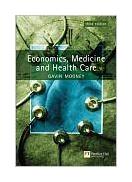|
||
• wydawnictwa polskie
• Zamów informacje o nowościach z wybranego tematu • kontakt
• Cookies na stronie |
ECONOMICS MEDICINE AND HEALTH CAREMOONEY G.wydawnictwo: FT/PH , rok wydania 2003, wydanie IIIcena netto: The book is suitable for Health Economics options within undergraduate and postgraduate economics degrees, and for use on Health Management, Nursing and Medical degrees. It is also appropriate for post-experience courses for health professionals. Professor Mooney, one of the leading scholars in health economics, introduces simple economic concepts and shows how an understanding of them contributes to health service policy making. The book's approach and coverage is strongly international, and care is taken throughout to make the text easily accessible to readers with no prior knowledge of economics. Contents List of contents Preface to the first edition Preface to the second edition Preface to the third edition 1 Introduction 2 Economics and health economics 2.1 Resource allocation problems 2.2 Supply and demand: the market 2.3 Economic evaluation 2.4 Conclusions 3 The nature of the commodity health care 3.1 Introduction 3.2 Defining health 3.3 Health and health care 3.4 Health care 3.5 Conclusion 4 Health status and other outcome measurement 4.1 Introduction 4.2 Some issues in measuring health 4.3 Quality adjusted life years ('QALYs') 4.4 Other outcomes 4.5 Conclusions 5 Values in health care 5.1 Whose values? 5.2 Valuing outputs 5.3 Que faire? 6 Need, demand and the agency relationship 6.1 Introduction 6.2 Demand and need for health care 6.3 Describing the agency relationship 6.4 Analysing the agency relatcionship 7 The inefficiency of medical ethics 7.1 Introduction 7.2 Ethics and medical ethics 7.3 The relevance of utilitarianism 7.4 Conclusion 8 Just health care: only medicine? 8.1 Introduction 8.2 What is equity? 8.3 Practical difficulties 8.4 An alternative approach based on 'capacity to benefit' 8.5 How should equity be defined? 8.6 Equity and ethics 8.7 What's best? 9 Priority setting in health care 9.1 Introduction 9.2 Priority setting using an explicit economics approach 9.3 QALY league tables 9.4 Priority setting: some other approaches 9.5 Conclusion 10 Health care financing and organisation 10.1 Introduction 10.2 Key features of public systems 10.3 Fair shares for all? 10.4 Fair-sharing and health care 10.5 Other insights from Margolis 10.6 Which system? 11 Some future roads to travel? 11.1 Introduction 11.2 Education 11.3 Information 11.4 Evaluation and monitoring 11.5 Does economic evaluation work? 11.6 Financing, budgeting and remuneration 11.7 Listening to the community 11.8 A final thought Index 146 pages
Po otrzymaniu zamówienia poinformujemy, |


